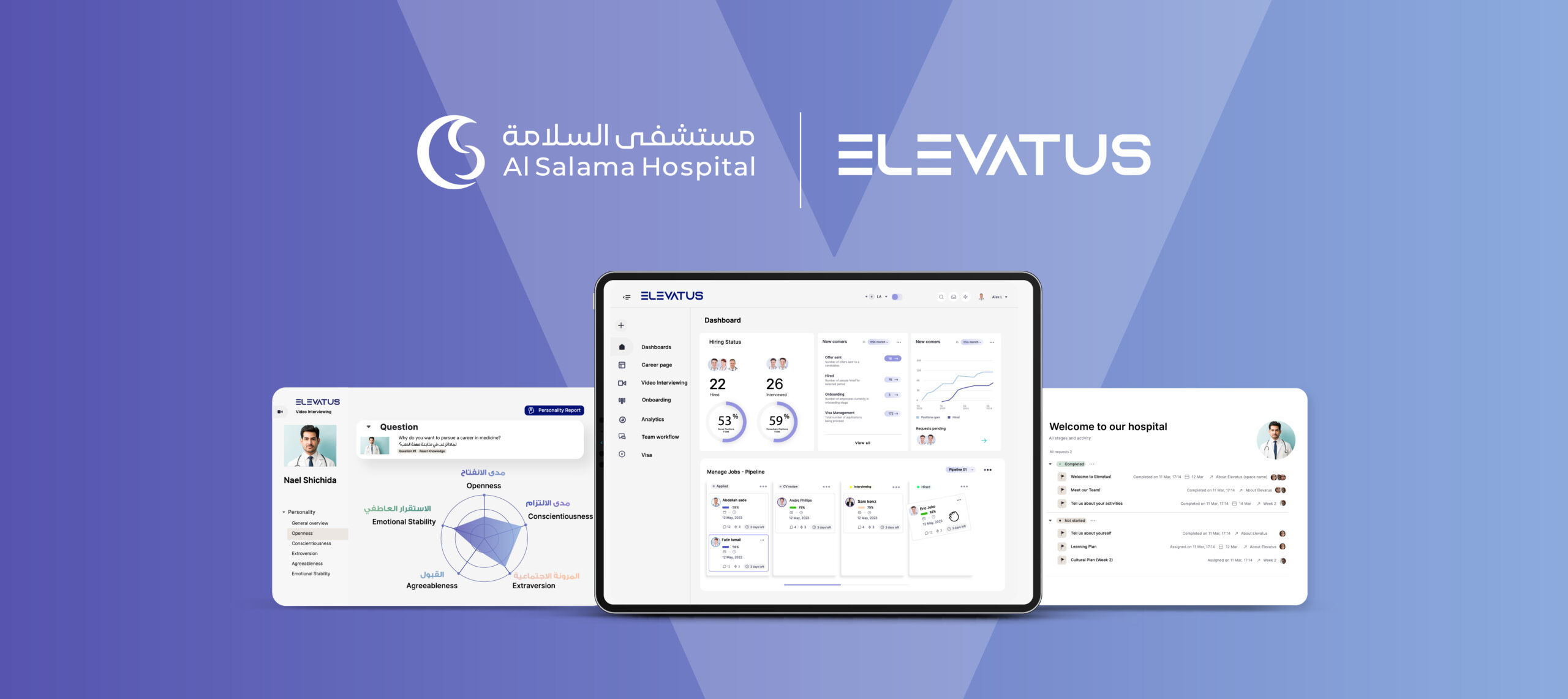
Applicant Tracking Systems
An A to Z Guide to an Applicant Tracking System to Unlock the Full Potential of Hiring
December 8, 2023



Kiran Kazim
Content Writer
Ever find yourself buried under a mountain of resumes, thinking there’s got to be a better way to handle this? You’re not the only one. It’s like every time you post a job, you’re swamped with applications. But somehow, that perfect candidate seems like a unicorn. Makes you wonder, doesn’t it? Is it just a waiting game, hoping the right person will pop up? Or is your hiring process missing a trick?
That’s where the idea of an applicant tracking system (ATS) comes in. But let’s be real: Is this just some fancy tech jargon, or is it the answer to your hiring headaches?
Let’s cut through the buzz, get to the heart of what is applicant tracking system is all about, and see if it really can turn your hiring process from a chore into a charm.
Table of Contents
Put your employer brand under the spotlight
Create a modern career page with an AI-powered ATS that showcases your brand identity and converts top talent fast.
Request a demoThe Role of an Applicant Tracking System (ATS) in Modern Hiring


In today’s fast-paced recruitment world, the applicant tracking system (ATS) stands as a beacon of efficiency and effectiveness. It’s not just a tool; it’s a revolution in the way companies attract, manage, and hire talent.
What is an Applicant Tracking System (ATS)?
An applicant tracking system is a specialized software that acts as a comprehensive platform for managing all aspects of the recruitment process. Think of it as your digital recruitment hub, where each application is meticulously organized, evaluated, and tracked.
At its core, an ATS automates the mundane and repetitive tasks of sorting through resumes. It uses a sophisticated algorithm to scan, rank, and filter applications based on specific criteria such as skills, experience, and education. This system is a lifesaver for recruiters and hiring managers who previously spent countless hours manually reviewing applications.
For example, EVA-REC is an award-winning applicant tracking system that uses cutting-edge technology and AI to automate and streamline the entire recruitment process. In one centralized place, HR teams can collaborate with company staff and use advanced analytics to evaluate candidates fairly and equitably. Using EVA-REC, you can be sure of not just hiring candidates but bringing on board high-caliber talent.
Here you can observe in the image below the depicted percentages from a survey conducted by Kelly OCG. It was found that approximately two-thirds (66%) of larger companies utilize Applicant Tracking Systems (ATS) in their recruitment processes. In contrast, a smaller proportion, about 35%, of small organizations have adopted ATS for their hiring needs.
The Unmissable Role of ATS in Modern Hiring
In an era where time is money and talent is gold, the ATS shines as an indispensable asset. Here, we’ll explore why ATS is a game-changer in recruitment, making the process smoother, faster, and more effective for companies of all sizes:
Streamlines Recruitment: The ATS simplifies and speeds up the recruitment process. It ensures that recruiters can quickly identify and focus on top-tier candidates, significantly reducing the time-to-hire. This efficiency is not just theoretical; users of EVA-REC, for instance, have observed up to an 80% reduction in time-to-hire, significantly streamlining their recruitment journey without compromising on the quality of hires.
Enhances Candidate Experience: With an ATS, companies can ensure timely and consistent communication with applicants. This enhances the candidate experience, reflecting positively on the employer’s brand. Within this context, EVA-REC takes candidate engagement to the next level. It provides a candidate experience that is modern, immersive, and extraordinary, engaging top talent in a memorable and distinctive manner.
Reduces Bias: By focusing on predefined criteria and qualifications, an ATS can help reduce unconscious bias in the initial screening stages, promoting a more diverse and inclusive workforce.
Data-Driven Insights: An ATS provides valuable insights into the recruitment process, from tracking the effectiveness of job postings to analyzing the efficiency of different hiring stages. For example, an end-to-end ATS like EVA-REC takes things to the next level with in-depth insights into all aspects of your recruitment process, empowering you to take immediate action and make data-driven decisions.
Why Applicant Tracking Systems (ATS) are the Game-Changer in Modern Hiring


Understanding what an applicant tracking system software is and how it functions is crucial for organizations looking to optimize their recruitment strategies. By efficiently managing large volumes of applications, an ATS helps recruiters identify, attract, and retain top talent, ensuring a more effective and less time-consuming hiring process.
Core Functionalities of Applicant Tracking Systems
Applicant tracking systems (ATS) are designed to revolutionize the recruitment process, offering a range of functionalities that streamline candidate management and hiring. Here’s an overview of the core functionalities these systems provide, making them indispensable tools for efficient recruitment
Job Posting and Distribution: An ATS simplifies the job posting process. It allows for the publication of job listings across multiple platforms, including online job boards, company career portals, and social media networks. This ensures a wider reach and increased visibility for job advertisements. Specifically, with a solution like EVA-REC, this process becomes even more efficient. EVA-REC allows for seamless job posting on over 2,000 job boards, eliminating the need for time-consuming manual postings. This streamlined approach ensures that job ads gain maximum exposure with minimal hassle, making the process of attracting a global audience as simple as a few clicks.
Applicant Management: Most applicant tracking systems are adept at organizing and managing candidate information. They efficiently sort and track applications, making it easy for hiring managers to access and review candidate profiles.
Resume Parsing and Screening: One of the key functionalities of an ATS is its ability to parse and screen resumes. By scanning for specific keywords and criteria, the system filters candidates, identifying those who best match the job qualifications. This automation significantly reduces the manual effort involved in the initial screening process.
Interview Scheduling: An ATS can also automate the interview scheduling process, facilitating seamless communication between recruiters and candidates. This feature helps in efficiently managing multiple interviews, ensuring a smoother hiring process.
Reporting and Analytics: The in-built analytics capabilities of an ATS are not just features; they are essential tools for gaining valuable insights into various aspects of the hiring process, such as time-to-hire and cost-per-hire. These analytics play a crucial role in refining recruitment strategies and enhancing overall efficiency. EVA-REC takes this a step further by offering tailored analytical reports that give you a birds-eye view of your recruitment process and metrics. It enables you to share progress with teammates effortlessly and identify areas for improvement in your recruiting process.
The Role of an Applicant Tracking System in the Recruitment Funnel
An applicant tracking system (ATS) plays a pivotal role in the recruitment funnel, serving as a key tool in managing and optimizing the entire hiring process. It acts as a central hub, facilitating efficient candidate tracking and selection from application to hire.
Attracting Candidates: By enabling the widespread posting of job openings, an ATS ensures that vacancies are visible to a broad audience, attracting a diverse pool of applicants.
Application Management: As the central hub for all applications, the ATS ensures that every candidate is accounted for and their information is easily accessible, streamlining the review process.
Screening and Shortlisting: By automating the screening process, the ATS efficiently narrows down the candidate pool, allowing recruiters to focus on the most suitable applicants.
Interviewing and Selection: The ATS plays a crucial role in scheduling and managing interviews, thereby facilitating a more organized and effective selection process.
Onboarding: Some ATS platforms extend their functionality to include aspects of the onboarding process, ensuring a smooth transition for new hires.
In summary, an HR applicant tracking system is an integral tool for modern recruitment. Its ability to manage and streamline the hiring process not only saves time and resources but also enhances the overall quality of hiring. By understanding and leveraging the capabilities of an ATS, organizations can significantly improve their recruitment outcomes, securing the best talent in a competitive landscape.
How Applicant Tracking Systems Offer Relief to Some Commonly Acknowledged Pain Points


As we mentioned earlier, applicant tracking systems (ATS) have become a cornerstone in modern recruitment, offering solutions to various challenges that hiring teams commonly face. By integrating technology into the recruitment process, ATSs provide relief to several pain points, enhancing efficiency and effectiveness.
| Pain Point | Relief |
|---|---|
| Submitting the same job ad to multiple job boards takes a lot of time and money. | An ATS integrated with job boards can post to a wide range of them with a single submission, saving time and expanding the reach of the job ad. |
| Valuable time is wasted on irrelevant applications. | ATSs can automatically filter applications or highlight priorities on the form, ensuring only suitable candidates are forwarded for review. |
| Interviewing is often unstructured, leading to poor selection decisions. | An ATS helps create a structured interview process by funneling suitable candidates and providing comprehensive profiles for informed preparation. |
| Coordinating interviews and maintaining communication with candidates is complex and time-consuming. | An ATS integrates with email and calendar systems, simplifying scheduling and communication and ensuring timely information flow. |
| The hiring process can be lengthy, leading to the loss of qualified candidates. | ATSs streamline the hiring process, reduce time to hire, and maintain candidate engagement, preventing bottlenecks and keeping the process smooth. |
The Technical Aspects of Applicant Tracking Systems


Applicant tracking systems (ATS) represent a significant leap in the way organizations handle recruitment, merging advanced technology with traditional recruitment practices. These systems are not just repositories for resumes; they are sophisticated tools that use complex algorithms and data analysis techniques to streamline the entire recruitment cycle. Understanding the technical aspects of these systems is crucial for organizations to maximize their potential and ensure seamless integration with existing HR practices.
Hire the right candidates faster
Easily collaborate with your team to evaluate candidates, gather feedback, and decide who’s the best fit, with our award-winning recruiting software.
Request a demoHow ATS Software Parses and Organizes Applicant Data
One of the most impressive features of an ATS is its ability to parse and organize vast amounts of applicant data. When a candidate submits a resume, the ATS uses natural language processing (NLP) and machine learning algorithms to analyze the content. This process involves extracting key pieces of information, such as work experience, educational background, skills, and other relevant credentials. The ATS then categorizes this data, often tagging and ranking candidates based on the job requirements.
This sophisticated parsing goes beyond mere keyword matching. Advanced applicant tracking systems like EVA-REC can interpret the context around keywords, understanding, for example, the difference between a candidate who “managed a team” and one who “worked in a team.” This depth of analysis allows for a more nuanced understanding of each candidate’s experience and skills, leading to a more accurate match between job requirements and applicant capabilities.
Integration with Other HR Software and Systems
An ATS doesn’t operate in isolation but is often part of a larger ecosystem of HR software and systems. Its ability to integrate seamlessly with other tools is crucial for creating a comprehensive HR technology suite. Common integrations include:
- Human Resource Information Systems (HRIS): An ATS can share data with HRIS platforms, allowing for easier transition of candidate information once they are hired. This integration ensures continuity from the recruitment phase to employee management processes.
- Onboarding Software: Integrating an ATS with onboarding software can make the transition from candidate to employee smoother. Once a candidate is hired, their data can be automatically transferred to the onboarding system, streamlining the process.
- Payroll Systems: Some ATS can link with payroll systems, facilitating the transition from recruitment to payroll once a candidate is hired.
- Performance Management Systems: Data from the ATS can be used in performance management systems to track the progress of new hires, linking hiring data with employee performance.
These integrations help create a unified HR workflow, reducing manual data entry, minimizing errors, and ensuring a consistent data flow throughout the employee lifecycle. For example, with the use of EVA-REC, this streamlined process is taken to the next level by using its DocuSign integration. It offers built-in e-signature capabilities, allowing for faster signing of offers and a more professional, efficient scheduling of meetings. This is all centralized in one platform for ease and convenience.
Data Security and Privacy Considerations
In the digital age, data security and privacy are paramount, especially when handling sensitive personal information. ATS providers must adhere to stringent data protection regulations, such as the General Data Protection Regulation (GDPR) in the European Union and other local laws. Key considerations include are shown in the table below:
| Consideration | Concise Description |
|---|---|
| Data Encryption | Essential for protecting data, both at rest and in transit, from unauthorized access. |
| Access Controls | Robust systems to ensure only authorized personnel access candidate data. |
| Compliance with Regulations | Adherence to data protection laws like GDPR for legal and ethical data handling. |
| Regular Audits and Updates | Continuous security checks and software updates to counter cyber threats. |
| Candidate Consent and Transparency | Clear communication and consent mechanisms for candidates regarding data use. |
In short, the technical aspects of applicant tracking systems are multi-faceted, involving advanced data parsing, seamless integration with other HR tools, and rigorous data security measures. These systems not only enhance the efficiency of the recruitment process but also ensure a high level of accuracy in candidate selection and compliance with data protection standards.
Unveiling the Benefits of Using an Applicant Tracking System
The implementation of an applicant tracking system (ATS) in the recruitment process marks a transformative step for organizations. This technology is not just about managing resumes or tracking applications; it’s about reinventing the recruitment strategy. An ATS offers many benefits, from streamlining administrative tasks to improving the quality of hires. It’s a tool that aligns with the goals of modern businesses, prioritizing efficiency, data-driven decisions, and an enhanced candidate experience.
Enhanced Recruitment Efficiency
One of the primary advantages of an ATS is the significant increase in recruitment efficiency. By automating several time-consuming tasks such as posting jobs on multiple platforms, sorting through applications, and scheduling interviews, an ATS drastically reduces the manual workload for HR teams. This automation allows recruiters to focus on more strategic aspects of their role, like engaging with candidates and strengthening employer branding.
Faster processing times also mean that positions can be filled more quickly, reducing the time-to-hire and improving the overall productivity of the recruitment process.
Improved Quality of Hire


An ATS enhances the quality of hire by enabling a more structured and systematic approach to candidate evaluation. By using sophisticated algorithms to parse and screen resumes, these systems ensure that the most qualified, suitable candidates are considered. This precision reduces the likelihood of human error or bias in the initial screening process, ensuring a more diverse and competent workforce.
Furthermore, the ability to track and analyze previous successful hires helps in refining the selection criteria, continually improving the hiring process.
Better Candidate Experience
The candidate experience is crucial in a competitive job market. An ATS streamlines the application process, making it more user-friendly and accessible. Candidates receive timely updates and feedback, reducing the uncertainty and frustration often associated with job applications.
A positive candidate experience not only enhances the company’s reputation but also increases the likelihood of successful hires accepting job offers.
Build a candidate experience that comes first
See how our award-winning ATS can help you deepen your talent pool and fill positions faster by building an immersive and modern candidate experience.
Request a demoData-Driven Decision Making
ATSs provide valuable insights through data analytics and reporting tools. These insights help in making informed decisions based on actual data rather than intuition.
An advanced analytics dashboard gives you a detailed breakdown of core recruitment metrics including:
Jobs: You can get instant insights on job openings, position views, time-to-fill, video assessments, published job overview, job status overview, and how many jobs were published and archived.
Candidates: Here, you can track and get an overview of candidate sources, the total number of candidates disqualified, and the candidates hired. You will also get deeper insights on the time saved, cost saved, time-to-disqualify, and time-to-hire.
Team members: From this section, you can instantly spot the active time duration for each team member and the activity logs of your team members
Questionnaire and events: Here, you can view any previous or upcoming events that you have, the response rate for each questionnaire, and you can also compare the number of events grouped by type (e.g. video assessment, online, or offline).
Cost Reduction in Hiring
Implementing an ATS can lead to significant cost savings in the recruitment process. By automating various stages of hiring, the system reduces the need for additional staff or external agencies.
Efficient processing of applications and faster hiring cycles also mean reduced costs associated with vacant positions. Moreover, better quality hires can lead to lower turnover rates, decreasing the long-term costs of recruiting and training new employees. Specifically, with EVA-REC, users have experienced a dramatic 96% decrease in hiring costs, showcasing its substantial impact on making the recruitment process more cost-effective.
Enhanced Collaboration Among Hiring Team


An ATS facilitates better collaboration among the members of the hiring team. With centralized data and communication tools, team members can easily share information, provide feedback on candidates, and make collective decisions. This unified approach ensures consistency in the hiring process and helps in selecting candidates who are a good fit for both the role and the company culture.
Scalability for Growing Businesses
For growing businesses, scalability is a key concern, and an ATS is designed to grow with the organization. Whether it’s handling a larger volume of applications, expanding to new locations, or adapting to changing recruitment needs, an ATS can scale accordingly. This adaptability ensures that the recruitment process remains efficient and effective even as the organization evolves.
Integration with Other HR Systems
An ATS can integrate seamlessly with other HR systems, such as payroll, performance management, and onboarding tools. This integration creates a smooth transition from candidate to employee, ensuring a consistent flow of information and reducing the need for redundant data entry.
Integrated systems provide a more comprehensive view of the employee lifecycle, from recruitment to retirement.
Strategic Talent Pooling
An ATS allows organizations to build a strategic talent pool. This pool is a database of potential candidates who may not have been fit for previous roles but could be ideal for future openings. By maintaining a relationship with these candidates, companies can quickly fill vacancies with qualified individuals who are already familiar with the organization. This proactive approach to recruitment not only saves time but also strengthens the employer brand by showing a genuine interest in potential employees.
In a nutshell, implementing an ATS is not just about upgrading a tool; it’s about transforming the entire recruitment strategy to meet the challenges of a dynamic business environment.
How to Choose the Right Applicant Tracking System and Unlock Hiring Success?
Selecting the right applicant tracking system (ATS) is crucial for any organization aiming to enhance its recruitment process. An ATS impacts the overall quality of your workforce. With a number of options available in the market, choosing the right system can be a daunting task. It requires a thorough understanding of your organization’s needs, knowledge of the key features to look for, and a strategic approach to comparing and selecting vendors.
Identifying the Needs of Your Organization


The first step in choosing an ATS is to understand the specific needs and challenges of your organization. Consider the following aspects to ensure you make informed decisions that align with your strategic goals:
Size and Scalability: The size of your organization and its growth trajectory are critical. A small company might need a straightforward, user-friendly system, while a larger enterprise might require a more robust solution that can scale and integrate with other HR systems.
Recruitment Process Complexity: Analyze the complexity of your recruitment process. Do you deal with high volumes of applications? Do you need advanced features like AI-driven candidate screening or integration with social media for sourcing?
Industry-Specific Needs: Certain industries may have unique requirements. For example, a tech company might need a system that can effectively assess technical skills.
Budget Constraints: Clearly define your budget. Remember, the most expensive option isn’t always the best, and vice versa.
User Experience: Consider the user experience for both recruiters and candidates. An ATS should be intuitive and easy to use to ensure high adoption rates among your team.
Essential Features to Look for in an Online Applicant Tracking System
This segment is dedicated to outlining the key features that make an ATS effective. We’ll delve into what to seek out to ensure the system you choose not only meets but exceeds your recruitment and organizational needs.
Resume Parsing and Candidate Screening: Efficient parsing and screening capabilities are fundamental. Look for systems that can accurately parse resumes and have intelligent screening algorithms to match candidates to job requirements.
Integration Capabilities: The ATS should easily integrate with your existing HR software, such as HRIS, payroll systems, and onboarding tools.
Customization: The system should offer customization options to tailor workflows, job templates, and communication emails to fit your company’s branding and tone.
Reporting and Analytics: Robust reporting and analytics tools are crucial for tracking the effectiveness of your recruitment strategies and making data-driven decisions.
Compliance: Ensure that the ATS is compliant with employment laws and data protection regulations in your region.
Mobile Accessibility: With the increasing use of mobile devices, an ATS with a mobile-friendly interface or app is highly beneficial. Why does mobile-friendliness matter so much? Consider this: according to a survey by Indeed, a staggering 78% of candidates are using mobile devices to find jobs
Candidate Experience: Features that enhance the candidate experience, such as easy application processes and timely communication tools, are vital.
Vendor Comparison and Selection Process
In this part, we’ll guide you through the critical steps of comparing and choosing the right ATS vendor. We’ll provide insights on evaluating features, support, pricing, and compatibility to help you make a well-informed decision for your organization’s needs.
Research and Shortlist Vendors: Start with thorough research. Look for vendor reviews on sites like Capterra or GetApp, ask for recommendations from industry peers, and create a shortlist of potential options. For instance, EVA-REC, a popular choice among recruiters, boasts an impressive 4.8 rating on Capterra and an even higher 4.9 on GetApp, reflecting its reliability and user satisfaction. Such ratings can be a good indicator of a product’s performance and user experience, helping you to narrow down your choices effectively.
Request Demos and Trials: Before making a decision, request demos or free trials. This will give you a hands-on understanding of how the system works and whether it aligns with your needs. For instance, EVA-REC offers a free trial, allowing you to explore its features and usability firsthand. Utilizing such opportunities can help you make a well-informed decision, ensuring that the ATS you choose truly enhances your recruitment process.
Evaluate Customer Support: Good customer support is crucial for troubleshooting and assistance. Evaluate the vendor’s support system, including availability, responsiveness, and resources offered. A telling example is seen in a comparison on Capterra between EVA-REC and another popular tool, LinkedIn for Business. In this comparison, EVA-REC’s customer support is rated at an impressive 4.9, surpassing LinkedIn for Business, which holds a rating of 4.3. Such distinctions are important to note, as robust customer support can significantly enhance the overall user experience and effectiveness of the ATS.
Check for Updates and Upgrades: A good ATS vendor should regularly update and upgrade its software to stay ahead of technological advancements and changing recruitment trends.
Cost Analysis: Conduct a thorough cost analysis. Consider not just the initial costs but also long-term expenses, including updates, support, and additional features.
References and Case Studies: Ask the vendor for references and case studies. Speaking to current users can provide valuable insights into the software’s performance and the vendor’s reliability.
Contract and Terms: Carefully review the contract and terms of service. Pay attention to aspects like data ownership, cancellation policies, and any hidden costs.
By thoroughly understanding your organizational needs, focusing on essential features, and carefully evaluating vendors, you can select an ATS that not only meets your current requirements but is also capable of adapting to future changes and challenges in the recruitment landscape. The right ATS is not just a tool; it’s a long-term partner in your quest to build and maintain a high-quality workforce.
Implementing your Applicant Tracking System and Optimizing it


Implementing an applicant tracking system (ATS) and optimizing it for maximum effectiveness requires a strategic approach. Here are some key tips to ensure a smooth implementation and optimization process:
Plan and Define Objectives: Before implementation, clearly define what you want to achieve with the ATS. Identify key performance indicators (KPIs) like time-to-hire, cost-per-hire, and quality of hire to measure success.
Involve Key Stakeholders: Get input from all stakeholders, including HR, recruiters, and hiring managers. Their insights can help tailor the ATS to meet the specific needs of different departments.
Ensure Proper Training: Comprehensive training is crucial for all users. Ensure that the training covers all features of the ATS and is tailored to different user levels, from basic users to advanced administrators.
Data Migration: If you’re switching from another system, carefully plan the migration of existing data to the new ATS. Ensure data accuracy and integrity during the migration process.
Integration with Other Systems: Seamlessly integrate the ATS with other HR systems (like HRIS, payroll, etc.) to ensure smooth data flow and reduce manual data entry.
Customize Workflows: Customize the ATS to reflect your organization’s unique hiring process. This includes setting up templates for job postings, emails, and interview schedules.
Regularly Review and Update: Continuously monitor the performance of your ATS and gather feedback from users. Use this information to make necessary adjustments and updates.
Leverage Analytics: Utilize the ATS’s analytics and reporting tools to gain insights into your hiring process and identify areas for improvement.
Enhance Candidate Experience: Regularly review and update the candidate interface to ensure it is user-friendly and provides a positive experience.
Stay Compliant: Ensure your ATS remains compliant with relevant employment laws and data protection regulations.
Here this streamlined table provides a quick overview of essential steps for effectively implementing and optimizing an ATS.
| Steps | Description |
|---|---|
| Plan and Define Objectives | Set clear goals and KPIs. |
| Involve Key Stakeholders | Gather diverse insights. |
| Ensure Proper Training | Comprehensive user training. |
| Data Migration | Accurate data transfer. |
| Integration with Other Systems | Seamless system integration. |
| Customize Workflows | Tailor hiring processes. |
| Regularly Review and Update | Continuous ATS assessment. |
| Leverage Analytics | Utilize data insights. |
| Enhance Candidate Experience | Optimize candidate interface. |
| Stay Compliant | Adhere to legal regulations. |
By following these tips, you can ensure that your ATS not only integrates smoothly into your existing processes but also evolves continually to meet the changing needs of your organization and the broader recruitment landscape.
Final Thoughts
To conclude this topic, using an applicant tracking system is not just about keeping up with HR technology trends; it’s about unlocking the full potential of your hiring process. An ATS is a powerful tool that aligns with the dynamic needs of modern recruitment, ensuring organizations stay competitive in securing top talent. By leveraging an ATS, companies can look forward to more streamlined, effective, and forward-thinking hiring practices.
Still looking for the right applicant tracking system to make your seasonal hiring a breeze?
EVA-REC is an award-winning applicant tracking system suitable for industries of all sorts and companies of all kinds. With EVA-REC, you can automatically post jobs on 2,000+ global job boards, filter resumes fast, rank candidates in order of qualification, and seamlessly collaborate with teammates – all in one complete solution. Ready to experience it for yourself? Request a free demo today!
Frequently Asked Questions
This section addresses the most common queries about applicant tracking systems. From basic functionalities to advanced features, we’ll provide clear, concise answers to help deepen your understanding and assist in your decision-making process.
1. What is an applicant tracking system?
An applicant tracking system (ATS) is a hiring tool that automates and streamlines the recruitment process, from posting job ads to handling applications and facilitating candidate selection.
2. How does an applicant tracking system work?
An applicant tracking system works by collecting and organizing applicant data, filtering resumes based on specified criteria, scheduling interviews, and aiding in the decision-making process through data analysis and reporting features.
3. How can applicant tracking systems improve the selection process?
Applicant tracking systems improve the selection process by efficiently sorting and ranking candidates based on job requirements, reducing manual workload, and ensuring a fair, unbiased approach to candidate evaluation.
Turn top talent to employees fast
Hire, assess, onboard and manage top talent for every job. See how Elevatus streamlines everything; from acquire to new hire.
Request a demoAuthor



Kiran Kazim
Don't miss a thing!
Stay one step ahead. Subscribe and get the latest updates, news, and insights from Elevatus straight to your inbox.






